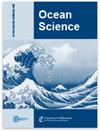预测海面温度和海洋热浪发生的机器学习方法:地中海案例研究
IF 4.1
3区 地球科学
Q2 METEOROLOGY & ATMOSPHERIC SCIENCES
引用次数: 0
摘要
摘要海洋热浪(MHWs)对社会和生态有重大影响,因此有必要对这些极端事件进行预测,以防止和减轻其负面影响,并为决策者提供有关海洋热浪相关风险的宝贵信息。本研究采用机器学习(ML)技术预测地中海 16 个地区的海面温度(SST)时间序列和海洋热浪。包括随机森林 (RForest)、长短期记忆 (LSTM) 和卷积神经网络 (CNN) 在内的 ML 算法被用来创建有竞争力的 SST 预测工具。ML 模型旨在预测未来 7 天内的 SST 和 MHW。对于每个地区,我们进行了 15 次不同的 ML 技术实验,逐步滑动从 1981 年到 2017 年的 4 年训练和测试期窗口。除 SST 外,我们还利用其他相关大气变量作为 MHWs 的潜在预测因子。欧洲航天局气候变化倡议(ESA CCI SST)v2.1 和欧洲中期天气预报中心(ECMWF)ERA5 再分析(1981-2021 年)的数据集被用于训练和测试 ML 技术。结果表明,对于每个地区,所有 ML 方法在 1 d 提前期的最小均方根误差(RMSE)约为 0.1 ℃,在 7 d 提前期的最大均方根误差(RMSE)约为 0.8 ℃。在所有区域,RForest 和 LSTM 在所有准备时间内的表现均优于 CNN 模型。在 11 个区域中,LSTM 在所有准备时间内的预测能力都是最高的。重要的是,在 SST 和 MHW 预报方面,ML 技术显示出与哥白尼地中海动态预报系统(MedFS)相似的结果,尤其是在预报早期。在 MHW 预报方面,ML 方法在 14 个地区的 3 d 预报时间内与 MedFS 的预报结果相当,而 MedFS 在 16 个地区中的 9 个地区的 5 d 预报时间内显示出更高的预报技能。所有方法预测每个地区 MHW 出现的置信度都大于 50%。此外,该研究还强调了入射太阳辐射与 SST 本身一样,都是预测 SST 变率的重要因素。本文章由计算机程序翻译,如有差异,请以英文原文为准。
Machine learning methods to predict sea surface temperature and marine heatwave occurrence: a case study of the Mediterranean Sea
Abstract. Marine heatwaves (MHWs) have significant social and ecological impacts, necessitating the prediction of these extreme events to prevent and mitigate their negative consequences and provide valuable information to decision-makers about MHW-related risks. In this study, machine learning (ML) techniques are applied to predict sea surface temperature (SST) time series and marine heatwaves in 16 regions of the Mediterranean Sea. ML algorithms, including the random forest (RForest), long short-term memory (LSTM), and convolutional neural network (CNN), are used to create competitive predictive tools for SST. The ML models are designed to forecast SST and MHWs up to 7 d ahead. For each region, we performed 15 different experiments for ML techniques, progressively sliding the training and the testing period window of 4 years from 1981 to 2017. Alongside SST, other relevant atmospheric variables are utilized as potential predictors of MHWs. Datasets from the European Space Agency Climate Change Initiative (ESA CCI SST) v2.1 and the European Centre for Medium-Range Weather Forecasts (ECMWF) ERA5 reanalysis from 1981 to 2021 are used to train and test the ML techniques. For each area, the results show that all the ML methods performed with minimum root mean square errors (RMSEs) of about 0.1 °C at a 1 d lead time and maximum values of about 0.8 °C at a 7 d lead time. In all regions, both the RForest and LSTM consistently outperformed the CNN model across all lead times. LSTM has the highest predictive skill in 11 regions at all lead times. Importantly, the ML techniques show results similar to the dynamical Copernicus Mediterranean Forecasting System (MedFS) for both SST and MHW forecasts, especially in the early forecast days. For MHW forecasting, ML methods compare favorably with MedFS up to 3 d lead time in 14 regions, while MedFS shows superior skill at 5 d lead time in 9 out of 16 regions. All methods predict the occurrence of MHWs with a confidence level greater than 50 % in each region. Additionally, the study highlights the importance of incoming solar radiation as a significant predictor of SST variability along with SST itself.
求助全文
通过发布文献求助,成功后即可免费获取论文全文。
去求助
来源期刊

Ocean Science
地学-海洋学
CiteScore
5.90
自引率
6.20%
发文量
78
审稿时长
6-12 weeks
期刊介绍:
Ocean Science (OS) is a not-for-profit international open-access scientific journal dedicated to the publication and discussion of research articles, short communications, and review papers on all aspects of ocean science: experimental, theoretical, and laboratory. The primary objective is to publish a very high-quality scientific journal with free Internet-based access for researchers and other interested people throughout the world.
Electronic submission of articles is used to keep publication costs to a minimum. The costs will be covered by a moderate per-page charge paid by the authors. The peer-review process also makes use of the Internet. It includes an 8-week online discussion period with the original submitted manuscript and all comments. If accepted, the final revised paper will be published online.
Ocean Science covers the following fields: ocean physics (i.e. ocean structure, circulation, tides, and internal waves); ocean chemistry; biological oceanography; air–sea interactions; ocean models – physical, chemical, biological, and biochemical; coastal and shelf edge processes; paleooceanography.
 求助内容:
求助内容: 应助结果提醒方式:
应助结果提醒方式:


